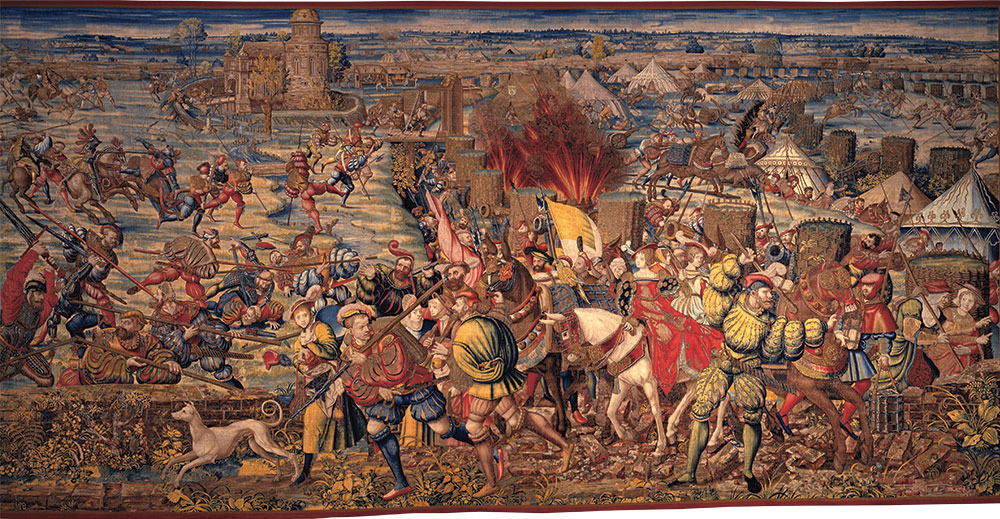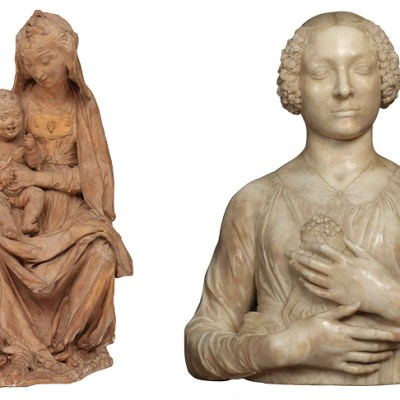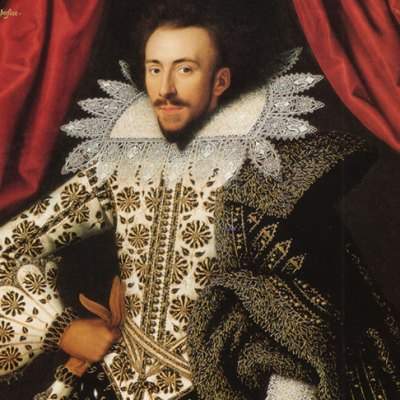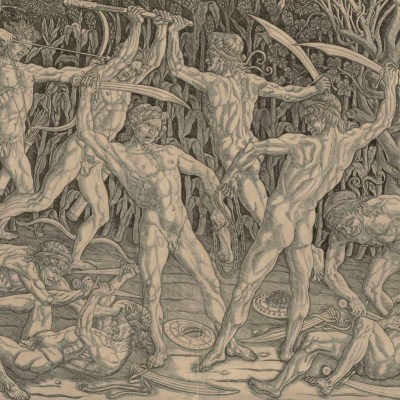At the centre of a spectacular and monumental tapestry that stands over four metres high, the Habsburg emperor Charles V (1500–58) sits mounted on a muscular rearing stallion surveying the vast panorama of Brussels before him, the heart of his Netherlandish court. The Month of March, from a set of 12 Hunts of Charles V, was designed for the emperor by the Habsburg court painter Bernard van Orley (c. 1488–1541) and woven by the Dermoyen workshop in Brussels, c. 1531–33. Woven of brightly coloured wool, silk, and gold and silver thread, the tapestry is filled with extraordinary detail, from the spurs on the feet of his entourage to a pair of great tits mating in the branches above, and represents the pinnacle of tapestry design and production in Brussels in the first decades of the 16th century.
The Month of March is one of more than 100 tapestries, paintings and drawings by Van Orley included in the first major monographic exhibition of the artist. It is being held, appropriately, in Brussels, the place of his birth, and is the result of a collaboration between BOZAR (the host venue) and other institutions in the city. Arranged chronologically by curators Véronique Bücken and Ingrid De Meûter, the exhibition introduces Van Orley’s early religious commissions, in the tradition of the Flemish primitives, before exploring the influence of artists such as Raphael and Albrecht Dürer on the development of his mature style, which unites Gothic tradition and Renaissance innovation. Given Van Orley’s pivotal role as one of the most enterprising artists of his generation, and his undoubted influence not just on his notable pupils, such as Pieter Coecke van Aelst, but on the broader evolution of Flemish art in the later 16th century, an exhibition that brings his work to a contemporary audience is long overdue.
The Virgin and Child Venerated by Saint Martin and Other Saints (c. 1510–15), Bernard van Orley

Van Orley, having likely trained as a painter in the studio of his father, Valentin, formed his reputation as the head of an important workshop in Brussels, producing portraits and altarpieces of popular subjects such as The Virgin and Child Venerated by Saint Martin and Other Saints (c. 1510–15) – this is one of two surviving panels from a series of three altarpieces created for abbot Jacques Coëne of the abbey of Marchiennes. Although Van Orley’s early religious commissions followed expected compositional conventions, each panel illustrating several episodes from a particular biblical story with key figures occupying intimate and luxurious interiors set within wider landscapes, the influence of the Italian Renaissance can start to be seen with the inclusion of new forms of architectural detail. As a master painter, Van Orley could also produce designs and full-size cartoons for sets of tapestries, the most expensive and highly prized of the fine and applied arts. By the 16th century, Brussels was a leading European hub of the tapestry industry: in 1545 an envoy of Cosimo I de’ Medici noted that 15,000 people – a third of the population – were involved in production. An early example, The Statue of the Virgin Welcomed with Great Pomp in Brussels (1516–18), from the Our Lady of Sablon series, demonstrates the high-quality design that was to establish Van Orley’s reputation in Brussels and beyond.
Christ in the Garden of Gethsemane (1520–22), workshop of Pieter Pannemaker, after a design by Bernard van Orley. Patrimonio Nacional, Madrid

In May 1518, Van Orley was appointed court artist to Margaret of Austria (1480–1530), governor of the Habsburg Netherlands and an enthusiastic patron of the arts. Her commissions for portraits, devotional paintings and sets of tapestries established Van Orley as the most prominent designer in Brussels for the next two decades. The period was also marked by a significant evolution in his style, in which the influence of the Renaissance came to the fore. This was informed in part by seeing Raphael’s set of 10 cartoons, the Acts of the Apostles, which had been sent to Brussels for weaving with Raphael’s pupil Tommaso Vincidor, to fulfil a commission from Pope Leo X for tapestries for the Sistine Chapel in the Vatican Palace. More significant, however, was his meeting with the titan of the German Renaissance Albrecht Dürer, whom he welcomed to Brussels in 1520; this marked the beginning of an exchange of ideas between the two artists that included the incorporation of figures and motifs after Dürer into Van Orley’s designs. The full extent of Dürer’s influence, and the rapidity of Van Orley’s stylistic evolution, are demonstrated by the tapestry series known as The Square Passion, two of which were ordered in 1518, followed by a further pair in 1522. Although they share an opulent use of materials and quality of production, the later tapestries are more monumental and emotionally expressive, the arrangement of the figures and landscape in Christ in the Garden of Gethsemane (1520–22) strongly influenced by Dürer’s 1508 wood engraving of the same subject.
As the leading defendant among a group of painters and weavers at a 1527 Lutheran heresy trial, Van Orley was imprisoned in Leuven for listening to heretical sermons. He was received into the court of Mary of Hungary (1505–58) five years later, concentrating his energies on the production of complex tapestry and stained-glass commissions and delegating painting to his workshop. Extravagant tapestry sets such as the Hunts of Charles V ooze imperial power: fittingly, they form the centrepiece of the exhibition. The Attack on the French Camp and the Flight of the Besieged (1525–31) is another such example, one of a set of seven known as the Battle of Pavia series presented by the States-General to the emperor to commemorate his victory over Francis I of France. Displayed here with the preparatory drawings for the entire scheme – which, fully realised, created a continuous panorama – the design conveys a powerful sense of drama, with courtly figures fleeing a scene of exploding siege batteries and sumptuously attired Landsknechte.
The Attack on the French Camp and the Flight of the Besieged from the Battle of Pavia series (1525–31), Dermoyen workshop, after a design by Bernard van Orley. Museo e Real Bosco di Capodimonte, Naples

Van Orley was proficient in designing for many different media, and mounting a comprehensive monograph of his work offers a number of challenges – notably, acknowledging the large-scale stained-glass commissions that were a significant part of his later career. The exhibition closes with an invitation to explore other venues in Brussels connected with his work, and it is well worth undertaking the short walk to the cathedral of St Michael and St Gudula where his stained-glass window designs assembled by master glass-worker Jean Haeck are a truly monumental spectacle, dominating the full height of the north transept. Commissioned towards the end of his life to memorialise the Habsburg dynasty, it is a fitting conclusion to the career of an often overlooked artist, whose work profoundly shaped the creative direction of Brussels.
‘Bernard van Orley: Brussels and the Renaissance’ is at BOZAR, Brussels until 26 May.
From the May 2019 issue of Apollo. Preview and subscribe here.



